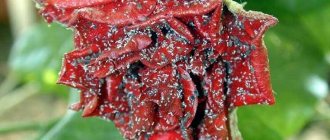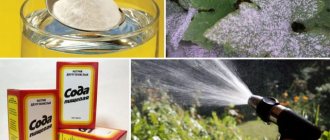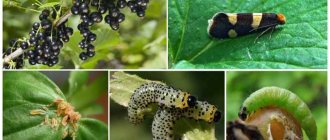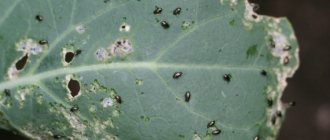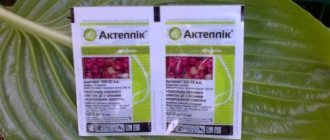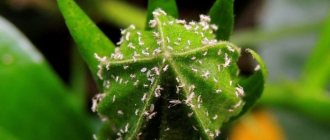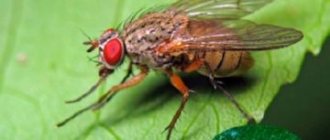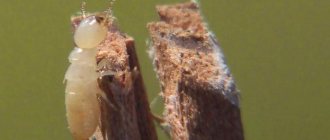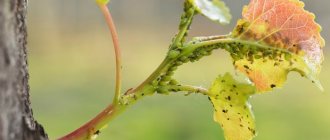5519
With the onset of summer, many pests appear in the garden that can cause significant damage to fruit plants. These include leaf rollers, spider mites, and scale insects. Aphid colonies on currants cause particularly harmful damage, so you need to figure out how to deal with them in advance. You can recognize her visit by curled leaves, characteristic swellings on them, and premature drying of the crown. In addition to the main damage, aphids lead to infection with vector-borne infections.
The harmful effects of aphids can be seen by curled and swollen leaves.
Why are aphids dangerous?
Aphids feed on the sap of leaves, shoots and flower buds of red and black currants, causing deformation, curling and wilting. It is a carrier of viral diseases such as:
- necrotic yellowness;
- mosaic viruses types I and II;
- terryness.
The honeydew produced by the pest attracts ants to the garden and leads to the appearance of black fungus.
Aphids overwinter on currant shoots in the egg stage, which are laid at the base of the buds. The first insects appear in early spring. Colonies form on shoots and leaves. Later, a winged form develops and leaves the plants for the summer. In the fall, the aphids return and lay winter eggs.
Vinegar
You can sprinkle currants with any known remedy that every housewife has in her kitchen. Vinegar against aphids helps save currants at any time during the growing season. Calmly use on a bush with berries.
Homemade recipes for aphids
Dilute 200 ml of table vinegar in 1 liter of cool water. Add 9 liters of liquid and 100 g of soap. The solution must be prepared immediately before use. Currant protection lasts 1-2 weeks. Depends on weather conditions. Vinegar drives away pests with its sour taste and pungent odor.
Important!
An effective vinegar-based aphid repellent requires precise dosage. An increased dose of acid leads to yellowing and death of leaves.
What aphid attacks currants: types and signs of damage to the bush
As a rule, the peak activity of aphids occurs in May-June, although the pest does not sleep during the summer, actively reproducing and populating the entire garden with its offspring.
The life cycle of aphids is as follows: in early spring, when the temperature rises, insects emerge from the laid eggs and begin to multiply quickly, feeding on plant juices. Malicious pests (wingless form) suck them out (the juices) with the help of their proboscis, piercing the youngest and most tender leaves, shoots and buds. When there are too many aphids and the plant dries out, a generation of a winged form is born, the individuals of which scatter to neighboring bushes. In autumn, eggs are laid in favorite places.
Typically, damage such as swollen, curled, and then reddened currant and gooseberry leaves with accumulations of larvae on the inside of young leaves indicates that a small and dangerous pest - aphids - has settled in your area.
Most often, currants are affected by two varieties of aphids, each of which prefers its own color of the berry: gall - red and white, and gooseberry - black.
Aphids and ants are good friends (faithful companions), since the latter love to feed on the carbohydrate secretions (molasses) of our small pests, carrying them from one place to another. So fighting aphids is also fighting ants.
Gall aphid (leaf)
If characteristic red spots in the form of swellings appear on red or white currants (these bubbles do not immediately acquire color), this means that your berry bush has been attacked by gall aphids.
As a rule, it hides precisely on the back side of the leaves and is very difficult to see, since it is even smaller than the melon, which attacks cucumbers (less than 2 mm).
If you do not detect it in time and take appropriate measures, the leaves will gradually die off. Then, naturally, the yield will drop significantly, and the bush itself will begin to slowly die.
Gooseberry aphid (shoot)
You can detect that your blackcurrant has been attacked by gooseberry aphids by looking at the curled leaves on the tops of the shoots (similar to a cocoon).
Leaves twisted into cocoons are very convenient for aphids for their own protection, because predator insects cannot see them.
If you unfold these leaves, you will see a huge number of aphids and their eternal companions, or rather defenders and carriers - ants.
Because of this, the fruits of the bush begin to shrink, they lose their taste, and they may even begin to fall off spontaneously.
Necessary actions
Digging the ground in autumn under currants
If in the summer aphids feasted on currants and measures to combat them were not so successful, we begin a new stage of the war with leaf fall. What you can do in the fall:
- We must collect fallen leaves and burn them. Aphid larvae may be hiding in them. Having awakened in the spring, insects will again take up the destruction of plants.
- We dig up the ground under the bushes. This is necessary so that the larvae in the soil die from winter frosts. Sprinkle the soil under the currants thickly with ash.
- We treat bare currant branches with insecticidal agents; you can also irrigate the dug up soil around the currant bush.
In early spring, even before the buds open, the bushes are treated by scalding the plant with boiling water. This seemingly barbaric method will not cause harm to currants; on the contrary, it will help strengthen immunity and resistance to various diseases. The same method helps in the fight against aphids overwintering in the buds.
Important! It must be remembered that scalding is one of a number of measures to combat aphids on currants. And it does not provide a 100% guarantee that insects will be destroyed.
Spraying currants with boiling water in early spring
Treatment with boiling water is carried out using a watering can with a diffuser. The bush is irrigated from top to bottom, going around it in a circle. If you carefully tie the branches with a rope, the scalding process is easier and faster. Dousing is carried out in the morning or afternoon so that the bushes have time to dry and are not covered with ice in case of night frosts. But if you are a little late with irrigation with boiling water, you will have to use other methods of combating aphids.
If in the summer the enemy was found on the bushes, but only a small number of shoots and leaves were damaged, you can carefully cut off the tops and burn them, and treat the remaining greenery with some folk remedy for aphids.
In summer, you can also launch a biological war against aphids. To do this, you need to attract insects that feed on it as allies: ladybugs, hoverflies, lacewings. If there are not enough individuals for complete victory, the larvae of these insects are purchased at gardening centers. They populate the garden with allies if the affected area is sufficient, otherwise the beneficial insects themselves may die from lack of food.
Traditional methods of fighting aphids
It is recommended to fight aphids on currants with folk remedies in case of moderate pest infestation. If the ecological recipe is used correctly, there will be no need for chemicals on the site. Practice-proven methods are based on pollinating bushes with herbal powders or spraying plantings with solutions.
Protecting berry fields with natural compounds involves several stages of using the chosen method. A slight violation of the frequency, timing and recipe - and the aphids return.
Soda Ash
The mixture is prepared from 10 tbsp. l. soda and 10 liters of water. The powder should completely dissolve. Before spraying, add a little soap solution to the product.
Hydrogen peroxide
Mix 50 ml of hydrogen peroxide, 50 ml of alcohol and 10 liters of distilled water. Spray on the undersides of leaves of infected plants. Use once a week (preferably after rain).
Using tobacco against aphids
The simplest treatment of currants against a dangerous pest is spraying with tobacco dust. Used as prophylaxis in early spring. The product is effective against gall aphids.
If the pest is found on a bush at the beginning of the growing season, a liquid concentrate is prepared from tobacco. 100 g of dust is dissolved in 1 liter of warm water, add 50 g of laundry soap. The composition is brought to a boil in a water bath and removed from the stove. 300 g of broth is dissolved in a 10-liter bucket and the bush is sprayed with the working solution. Treatment of currants is repeated 3 times at intervals of 2-3 days.
Ammonia
Ammonia (ammonia) is a nitrogenous compound that is suitable for killing aphids, and will also be useful for the plant itself for growth and development. You need to make the following composition: combine 100 g of laundry soap, 50 ml of ammonia, 10 liters of water. Mix thoroughly and spray the aphids on the currants. This product is used in the first half of summer, when plants require nitrogen for active growth.
All homemade folk remedies have one drawback: they have a “mild” effect on insect pests without causing harm to plants. Such methods are used for prevention or at the first signs of infection, when a colony of aphids has just appeared on currants.
Soap, added to different compositions, serves as a kind of glue. It helps other substances linger on the lower parts of the leaf blades. Berry bushes are sprayed several times during the growing season, repeating the procedure after 7–10 days. For an adult currant bush, approximately 1.2-1.5 liters of the prepared preparation are usually consumed. It is better to fight aphids on currants using folk remedies in the evening, when the weather is calm and windless. Treatments are not recommended during the flowering period and a few days before harvest. Otherwise, pungent-smelling herbal and drug compounds may be present in the taste and smell of currants.
Infusion of marigolds
The infusion effectively fights gall aphids. To obtain the product, pour half a bucket of crushed flowers and green mass of the plant with 10 liters of water. Leave for 3 days, filter the prepared solution through gauze.
Mustard infusion
To get rid of aphids on currants, an infusion is prepared from mustard powder. 15 g (1 tablespoon) of raw materials are diluted in 1 liter of water and kept in a warm place for 2 days. Before use, the volume is adjusted to 5 liters. If the pest has tightly adhered to the currants, the proportion of the infusion is 1 liter per 20 g of powder. This composition will also poison the leaf roller butterfly, which is often adjacent to aphids.
Pine infusion
A kilogram of pine needles (preferably pine) is poured with 5 liters of boiling water and left for 7 days. For preventive use, the concentrate is diluted to 10 liters; in case of a massive aphid infestation, problematic currant bushes are sprayed with a concentrated infusion. After treating the bushes with a diluted product (ratio 1:5), the soil under the currant plantings is treated.
Onion peel infusion
Onion infusion is a lifesaver if you need a quick and guaranteed effect. It helps well against gall or gooseberry aphids, and can be used during the fruiting period of currants. In addition to getting rid of pests, it saturates berry plants with useful substances.
To prepare, take 200 g of husk and place it in a zinc bucket, then pour 10 liters of boiling water. They form a “bath” - place a large pan on top of the bucket with the solution and wrap it well. Leave for 10-15 hours. Infected currant bushes are sprayed with undiluted infusion.
Infusion of potato or tomato tops
An infusion of tops of nightshade crops (primarily potatoes and tomatoes) removes all types of aphids. It is also an excellent help against codling moths, sawflies and mites. The harmful effect of the infusion is given by toxic salonin in the composition of potato and tomato tops.
4-5 kg of green mass are poured into 10 liters of water and simmered over low heat for 30-40 minutes. Soap is added after cooling. Before spraying, the concentrate is diluted with water in a ratio of 1:5.
Ash infusion with wormwood
The infusion is quickly prepared, and therefore good for urban summer residents. Dosage: 500 g of wormwood, 300 g of wood ash and 50 g of soap. The ingredients are poured into 10 liters of water and left for 5 hours. After filtering, the solution is diluted halfway with water.
Infusion of celandine
If there is any doubt about the type of pest, celandine will help. The ubiquitous weed effectively exterminates both gall and gooseberry aphids. However, such an infusion should not be used when fruit ovaries appear on currants.
Pour 3-4 kg of freshly cut grass into a 10-liter bucket and leave for 12-15 hours. Be sure to strain the finished infusion before spraying.
Soap solution
In everyday life, by soap solution, gardeners mean any alkaline composition. To obtain the drug, add 3-4 tbsp to 1 liter of water. spoons of dishwashing detergent, washing powders, liquid or grated laundry soap. Tar soap gives a good result in case of severe damage to plantings. A 100-gram piece is dissolved in 10 liters of water and sprayed onto the plantings. The pungent smell of tar repels pests.
Another effective remedy is a soap-soda solution. Dissolve a piece of laundry soap in 4-5 liters of hot water and add 4 tbsp. spoons of soda ash. In the absence of rain, treatment for 2-3 weeks prevents the appearance of aphids.
Fumigation of currant bushes
Close to the currant plantings they burn objects that do not so much burn as smolder. These are rubber, caoutchouc, tobacco, raincoat mushroom. Plumes of acrid smoke destroy ripening eggs and colonies of aphids, the smell of burning and ash residues repel new pests.
Fumigation of currants is carried out on a cloudy day in calm weather. A piece of suitable material is placed in a pan or flask and set on fire. To prevent active combustion, cover the container 2/3 with a lid. The “device” is placed under the currant bushes for 2-3 hours.
Milk and iodine
The composition helps to get rid of any type of aphids on currants. A liter of cow's milk is diluted with 10 liters of water, then 5 ml (1 teaspoon) of iodine is added to the mixture. Soap is not used: milk fat acts as a protective film. It is important to observe the dosage of iodine, otherwise you can burn the currant foliage. Milk can be replaced with whey. In this case, 50 g of birch tar soap is added to the ingredients.
Iodine-milk treatment is a good leaf-based fertilizer. The mixture contains amino acids, calcium and phosphorus. During the season, the treatment against aphids is repeated 3-4 times, and in the fall the currant harvest will delight you with large juicy berries of a rich color.
Fumigating branches with burnt rubber helps kill aphids
Keep in mind that folk remedies cannot be compared with chemical pesticides, so they are applied regularly and often.
They not only save the bush from aphid invasion, but also feed:
§ nitrogen, when adding ammonia solution to the roots (50 ml: 10 l of water). Laundry soap (100 g) is used as an adhesive. Repeated treatment is carried out after 2 weeks.
§ when spraying shoots with soda solution (10 tbsp: 10 l of water: 100 g of soap), the plant is enriched with calcium.
§ in May, wood ash is sprinkled on the currant roots or sprayed with an ash solution (200 g: 10 l of water).
§ Tobacco replenishes the deficiency of nitrogen and phosphorus, and also repels pests. First, the bushes are treated with a soap solution and sprinkled with tobacco dust.
Chemicals
They are used with caution. Chemical sprays can be harmful to human and animal health. Today's market recommends the following products:
- Aktara. Fast acting due to good absorption by plants.
- Actellik. Organophosphate insecticide. More toxic than other drugs. Increased security measures are required.
- Fufanon. Effectively fights against herbivorous parasites.
- Alioth. Penetrating into plants, it affects insects upon contact with the outer shells, entering the intestines and inhaling vapors.
- Biotlin. Aphids and their larvae die within a few hours after treatment. The protective effect lasts 14-21 days.
- Inta-vir. The drug is safe for people and animals. Leads to paralysis of pests.
- Karbofos. Acts against sucking and leaf-eating parasites. Moderately toxic.
- Kinmiks. Paralyzes the nervous system of adult aphids and larvae.
- Tanrek. Penetrates into leaves, stems and roots of currants.
Leaf gall aphid (Capitophorus ribis)
This small insect most often damages white and red currants. In the spring, when the first leaves bloom, larvae appear, which settle on the underside of the leaves and suck the juices out of them. Gradually, these larvae become the founders of a new colony, damaging more and more leaves. Red swellings appear on their outer surface. Then the leaves begin to die, a drop in yield and the gradual death of the entire plant.
Leaves damaged by aphids
Plants against aphids on currants
Currants grow in one place for decades, and crop rotation cannot be applied to a berry garden. Repellent plants planted around the bushes will help out. They will protect currants from aphids during the period of berry ripening, when it is impossible to treat them with chemicals.
Planted nearby:
- marigold;
- calendula;
- lavender;
- mint;
- garlic;
- coriander;
- sage.
These plants abundantly distribute fragrant essential oils around, which protects the currants. The “fragrant” curtain physically prevents aphid nests from appearing.
Soda
During fruiting, it is necessary to use the safest means possible. Soda for aphids is one of them. Use food grade, calcined.
The bush can be treated with the same product during flowering. Baking soda saturates the plant with calcium, promotes the formation of fruits, destroys pathogens, and prevents diseases.
10 tbsp is diluted in 1 liter of water. spoons of baking soda, or 2 tbsp. calcined spoons. Add 100 g of laundry soap, 9 liters of cold water. You can spray currants against aphids with soda solution from a garden spray bottle or a spray bottle, paying special attention to the lower part of the leaves on the bush.
Important!
To consolidate the effect, repeat the procedure after 3 days. If you used soda ash before, it is better to use baking soda a second time.
When and how to treat?
When fighting aphids, the following rules are observed:
- when using an agricultural product for the first time, you need to try it on a small area;
- if the drug is too strong, the effect will appear within twenty-four hours;
- use chemicals strictly according to instructions;
- do not spray during the flowering period;
- do not process plantings in rainy and windy weather;
- spray not only the bushes, but also the ground underneath them.
Biological and mechanical methods
When the infection has just begun and is not yet widespread, or when the berries have begun to set, chemicals should not be used.
There are methods for removing aphids manually:
- To do this, the affected areas are carefully cut off and burned.
- Aphids can be washed off the bush with water pressure.
- Destruction of aphids with gloved hands.
In the spring, infected buds are destroyed even before they begin to bloom. You can simply distinguish infected kidneys from normal ones by comparing them. Those in which pests live in the fall are round in shape and larger than usual.
Such mechanical methods are effective, but they have a number of disadvantages:
- this is a labor-intensive process that will need to be repeated regularly;
- currant bushes will need to be regularly inspected and the fight continued;
- If you do not destroy the infected buds in time, the fight against aphids will begin again.
A good way of protection would be to attract natural enemies of aphids to the garden plot. These include small birds, earwigs, and ladybugs. You can lure small birds, titmice and sparrows to the site by installing feeders and drinkers.
They will repel aphids with their smell and attract beetles that will destroy them, planted next to currant bushes:
- marigold;
- cosmos;
- calendula;
- nasturtium;
- dill beds;
- tomatoes.
You should not grow corn in your neighborhood because aphids really like the juicy corn leaves. After their destruction, the pest will happily migrate to the currant bushes.
Experts advise, if necessary, to specifically introduce insects that prey on aphids. They can be bought at special markets where they sell things necessary for agriculture.
Weeds can be beneficial in this fight. Colonies of quinoa aphids are especially fond of it. If you leave it under the currant bushes, the aphids will move to the weed. When the pest moves on, the grass is removed from under the bushes to destroy it.
Preventive measures
As a preventive measure they practice:
- regular inspection of leaves;
- use of fertilizers with low nitrogen content;
- thorough weeding and mulching;
- fighting ants;
- pruning dry branches and removing old bark;
- loosening the soil and whitewashing the trunks in the fall.
To destroy aphids, you must use all available means. Modern technologies will help save time and effort. Home methods will eliminate any harmful effects on the future harvest.
Tips and tricks
- When treating currants against aphids with chemicals, personal protective equipment is worn - gloves, goggles, respirators.
- Spraying of bushes is carried out in the evening in dry, windless weather. In case of rain, repeat everything. Particular attention is paid to young currant shoots and the lower part of the leaf.
- They get rid of ants on the site: aphids live in symbiosis with them. The earthen “hard workers” are attracted by the milky secretion of the pest, and the ants actively protect the “breadwinners”, help migrate and “take” the aphids to spend the winter.
- If aphids have chosen cherries, cherry plums, currants and gooseberries, “heavy artillery” is used - chemicals and biological products. There is no point in relying on natural farming.
Aphids are a frequent “guest” in the garden.
To prevent the pest from becoming a permanent resident on currants, a triad of measures will help. Spring-autumn prevention of plantings, treatment of diseased bushes, maintaining order on the site. Traditional methods are safe, they often also “feed”, but require consistency. Chemistry is used in case of mass infection of currant plantings, if other methods are unsuccessful. Save and share:
Prevention measures
The main enemy of aphids is not chemicals or herbal infusions. The pest can be defeated through prevention, treatment and regular garden care.
Aphid repellers
Gall and gooseberry aphids are afraid of the smell of herbs and plants with a high content of alkaloids. To repel the pest, it is enough to attach branches of elderberry, oregano, and any honey plants to the currants. Onions and garlic, tomato and potato tops are also used.
How to treat tomatoes against aphids at home, read this article.
Weeding currant plants
You shouldn’t put into practice the newfangled advice “don’t injure the ground with a hoe.” Weeding destroys aphid nests in the soil and raises hidden pests from their hiding places for birds and natural enemies to see. Along the way, the soil is saturated with oxygen, which has a beneficial effect on the ripening time and quality of currant fruits.
Compliance with the rules for caring for currants
It is enough to use the usual rules of currant agricultural technology so as not to suffer with the removal of aphids:
- in the fall, remove fallen leaves, cut out root shoots and shoots on old currant branches (aphids often overwinter here);
- after cleaning the area, weed the root areas;
- ant nests are destroyed with boiling water with hydrogen peroxide and insecticides;
- the base of currant bushes is whitened, branches affected by aphids are removed;
- when planning currant plantings, shrubs are placed away from cherry plum and apple trees - aphids hide in the trunks of these trees for the winter;
- For prevention, the root soil is treated with potassium permanganate.
If pests and fungal-viral infections are detected on the site, measures are taken immediately, otherwise weakened plants will become “prey” for voracious aphids.
scalding
Destroys overwintered aphid eggs. Currant bushes are well poured with boiling water from a garden watering can. This must be done as soon as the snow melts - before the buds appear and the sap begins to flow.
